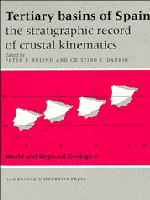Book contents
- Frontmatter
- Contents
- List of contributors
- Preface
- Dedication to Professor Oriol Riba IArderiu
- Memorial, Etienne Moissenet 1941–1994
- PART G GENERAL
- PART E EAST
- E1 Geological setting of the Tertiary basins of Northeast Spain
- E2 The lithosphere of the Valencia Trough: a brief review
- E3 Depositional sequences in the Gulf of Valencia Tertiary basin
- E4 Neogene basins in the Eastern Iberian Range
- E5 The Tertiary of the Iberian margin of the Ebro basin: sequence stratigraphy
- E6 The Tertiary of the Iberian margin of the Ebro basin: paleogeography and tectonic control
- E7 Stratigraphy of Paleogene deposits in the SE margin of the Catalan basin (St. Feliu de Codines – St. Llorenç del Munt sector, NE Ebro basin)
- E8 Onshore Neogene record in NE Spain: Vallès–Penedès and El Camp half-grabens (NW Mediterranean)
- E9 The Paleogene basin of the Eastern Pyrenees
- E10 The Neogene Cerdanya and Seu d'Urgell intramontane basins (Eastern Pyrenees)
- E11 Eocene-Oligocene thrusting and basin configuration in the eastern and central Pyrenees (Spain)
- E12 The Late Eocene–Early Oligocene deposits of the NE Ebro Basin, West of the Segre River
- E13 Chronology of Eocene foreland basin evolution along the western oblique margin of the South–Central Pyrenees
- E14 Evolution of the Jaca piggyback basin and emergence of the External Sierra, southern Pyrenees
- E15 Long-lived fluvial palaeovalleys sited on structural lineaments in the Tertiary of the Spanish Pyrenees
- E16 Evolution of the central part of the northern Ebro basin margin, as indicated by its Tertiary fluvial sedimentary infill
- E17 The Rioja Area (westernmost Ebro basin): a ramp valley with neighbouring piggybacks
- PART W WEST
- PART C CENTRE
- PART S SOUTH
- Index
E10 - The Neogene Cerdanya and Seu d'Urgell intramontane basins (Eastern Pyrenees)
Published online by Cambridge University Press: 04 August 2010
- Frontmatter
- Contents
- List of contributors
- Preface
- Dedication to Professor Oriol Riba IArderiu
- Memorial, Etienne Moissenet 1941–1994
- PART G GENERAL
- PART E EAST
- E1 Geological setting of the Tertiary basins of Northeast Spain
- E2 The lithosphere of the Valencia Trough: a brief review
- E3 Depositional sequences in the Gulf of Valencia Tertiary basin
- E4 Neogene basins in the Eastern Iberian Range
- E5 The Tertiary of the Iberian margin of the Ebro basin: sequence stratigraphy
- E6 The Tertiary of the Iberian margin of the Ebro basin: paleogeography and tectonic control
- E7 Stratigraphy of Paleogene deposits in the SE margin of the Catalan basin (St. Feliu de Codines – St. Llorenç del Munt sector, NE Ebro basin)
- E8 Onshore Neogene record in NE Spain: Vallès–Penedès and El Camp half-grabens (NW Mediterranean)
- E9 The Paleogene basin of the Eastern Pyrenees
- E10 The Neogene Cerdanya and Seu d'Urgell intramontane basins (Eastern Pyrenees)
- E11 Eocene-Oligocene thrusting and basin configuration in the eastern and central Pyrenees (Spain)
- E12 The Late Eocene–Early Oligocene deposits of the NE Ebro Basin, West of the Segre River
- E13 Chronology of Eocene foreland basin evolution along the western oblique margin of the South–Central Pyrenees
- E14 Evolution of the Jaca piggyback basin and emergence of the External Sierra, southern Pyrenees
- E15 Long-lived fluvial palaeovalleys sited on structural lineaments in the Tertiary of the Spanish Pyrenees
- E16 Evolution of the central part of the northern Ebro basin margin, as indicated by its Tertiary fluvial sedimentary infill
- E17 The Rioja Area (westernmost Ebro basin): a ramp valley with neighbouring piggybacks
- PART W WEST
- PART C CENTRE
- PART S SOUTH
- Index
Summary
Abstract
The Cerdanya, Seu d'Urgell, Conflent and Rosello basins began to form in the Miocene, as a result of the dextral slip of the La Tet and La Tec faults that extend ENE and WSW across the eastern Axial Pyrenees. The first stage of sedimentation was followed by an episode of basin inversion, which was, in turn, followed by a second stage of sedimentation in the Late Miocene (Late Messinian) and Pliocene. Plant material fossilised during the sedimentation provides evidence of the development of the present Mediterranean climate with warm and dry summers and cold and damp winters.
Introduction
The present relief of the Eastern Axial Pyrenees is characterized by wide ENE–WSW oriented valleys and depressions (Cerdanya, Conflent, Rosselló) along which the main rivers of this area run (Segre, La Tec and La Tet rivers). Partially modified by the Quaternary glacial processes, this morphology was caused by the development, during the Neogene, of a horst and basin system which is bounded by E–W and ENE–WSW faults (Fig. 1). The most prominent are the ENE–WSW La Tet and La Tec fault systems, which are formed by NE–SW right-stepping en echelon faults and E–W faults that developed at the end of its western block and in the overstep zones of the NE–SW faults.
The Cerdanya, Seu d'Urgell and the Conflent basins are related to the La Tet fault (Fig. 1) and formed on the NW side of this fault, where major extensional E–W faults developed (Fig. 2).
- Type
- Chapter
- Information
- Tertiary Basins of SpainThe Stratigraphic Record of Crustal Kinematics, pp. 114 - 119Publisher: Cambridge University PressPrint publication year: 1996
- 12
- Cited by



